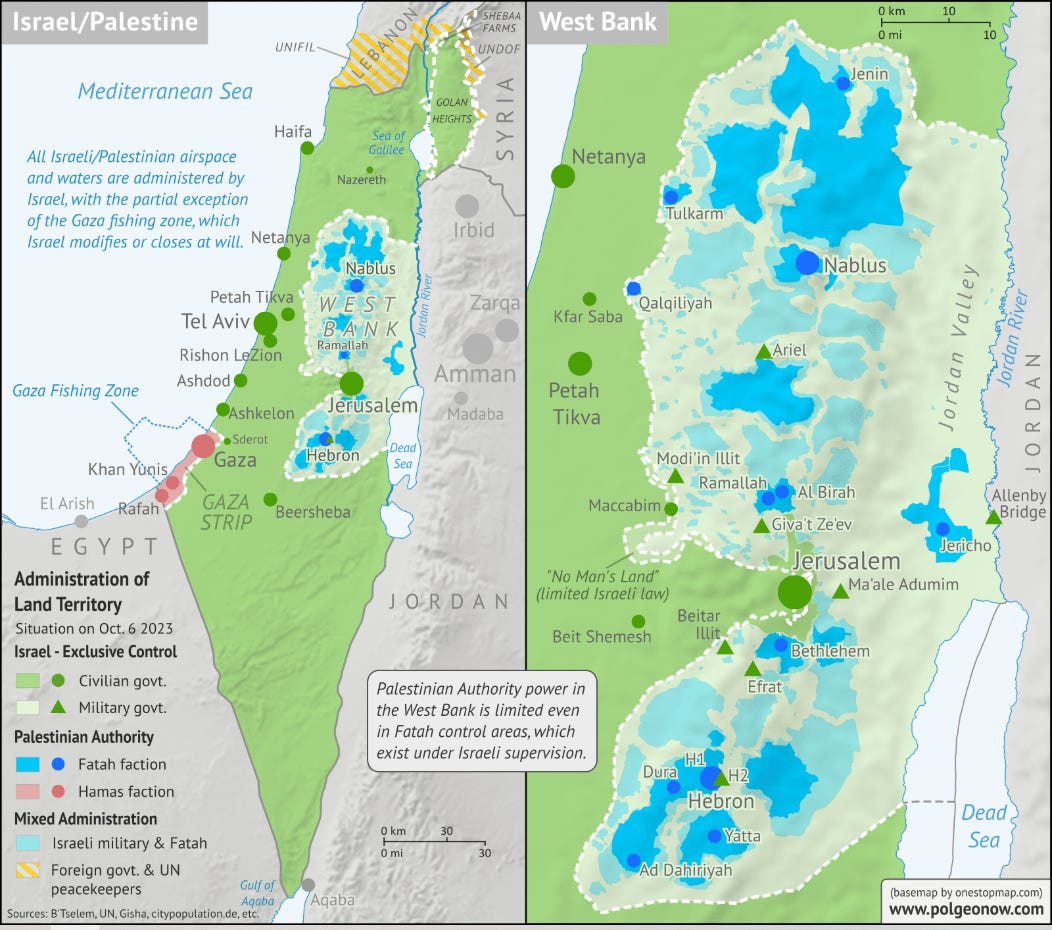Quick Take: Palestine Vs Israel, a Quick'n Dirty Summary
The hottest of all hot ethnic conflicts on the planet is still burning bright
(This piece is in response to a question by a paying subscriber, Kim L., who is interested to know the specific roots of the Israeli conflict with Hamas)
The Arab-Israeli conflict probably is the world’s most complex, since it has long and deep roots in ancient history as well as very recent triggers.
Judaism is an ethno-religion, so most people who are Jewish in the 21st century are descended from ancient Jewish people (not all, since conversion is accepted by some branches of Judaism) while Arabization is a much more complex process: lots of people who speak the Arab language and could be deemed to have an Arab culture, particularly along the margins of the Arab world (Iraq, Morocco, Sudan) have little if any genetic contact with the Arabs from Arabia, the people who were often called “Saracens” just before and after the era of Islamic expansion.
The Arabs of Palestine (“Palestinians”) are a typically Levantine cocktail. Looking at their genetics, in summary Palestinians are pretty average Middle-Easterns, with a large degree of genetic similarity to Arabs from Arabia — with whom there has been great inter-breeding — as well as the genetic profile of the ancient inhabitants of the region, the Canaanites.
There’s a great deal of Jewish blood in the Palestinian population, although perhaps a majority of its ancestry is Arab rather than Jewish. As in the Jewish population, one can also find a not insignificant degree of European ancestry: although in the Palestinian case it’s, likely, mostly derived from ancient Philistines (overwhelmingly Cretan Greeks, it would appear) who mixed up with marginal populations in the region rather than their Jewish enemies; in the Jewish case, most European blood is modern Western European (Ashkenazim).
In terms of culture, both populations appear to have evolved in parallel, with a great deal of exchange between them. The impression that some people have that Palestinians are the descendants of Arab invaders who took over Palestine after it was emptied of Jews by Roman persecutions is wrong.
Arabs native to Palestine are remarked upon as early as the 5th century BC by Herodotus. Many may have arrived as mercenaries since, as Herodotus notes, without the Arabs’ help the Persian invasion of Egypt a century earlier “would have been impracticable” (Histories, III).
Gaza Arabs, as loyal subjects of the Persian emperor, defended their land from Alexander the Great in the late Fourth Century BC, under the leadership of one Batis. In Transjordan, Arabs appear to have become a majority of the population starting in this era, as Arab migration from ever-drier lands of Arabia continued apace.
The Jews, of course, arrived earlier in Palestine. To a large degree, they can be said to be the oldest native population in the region that still survives as a distinctive group. To simplify a complex story, they resulted from the combination of Canaanite peoples who mixed up (peacefully or by force) with the Hyksos, a mostly Semitic group of chancers who tried and failed to take over Egypt and were eventually expelled from that country — a story that was later much prettified to give us the Biblical tale of Moses. I wrote extensively about the Hyksos here:
Hyksos: The Jews in Egypt
The word Hyksos, never used in Egypt, is a Greek-derived modern coinage deriving from the Egyptian expression “heqau khaswet”: "rulers of foreign[1] lands," commonly used in Egyptian texts to describe foreign chieftains and, later, Nubian warlords operating in south of the country as well as Asiatic warlords in the north.
Many things happened afterwards. Huge books have been written about this, but a real quick summary would be: the Jews, majority population of Palestine, kept rebelling against the Romans until the Bar Kokhba revolt led to massive loss of life and the Jews became just one of several groups in Palestine.
Talmudic Judaism, the intellectual consequence of that massive fail, put an emphasis on education and cultural transmission of the faith, which over the next two millennia led to the shrinking of the Jewish population via emigration or conversion to Christianity, first, and Islam later.
So, we get to the 19th century. Nationalism emerged as a powerful political force across Europe, then home to the vast majority of Jews across the world, and among Jewish communities that nationalism took a very specific form: Zionism, defending the creation of a Jewish homeland. European Jewish leaders examined various possibilities, and were eventually assisted in the task by eager anti-Semites who proposed various Jewish homelands in Uganda, Argentina, Madagascar, the Moon, etc. The Soviet Union later created a Jewish autonomous region in a particularly appalling chunk of Eastern Siberia. Pretty soon, it became clear that a re-make of the ancient Jewish state in Palestine was the only realistic plan.
During World War I, Zionists were helpful enough to the British Empire that the so-called Balfour Declaration promised them a “national home” in Palestine, then recently taken by the Brits from the Ottoman Turks, in part thanks to the efforts of Lawrence of Arabia. It doesn’t take a genius to perceive the irony:
Jewish migration from Europe (mostly the Ashkenazim Pale of Settlement in modern Poland, Belarus, Ukraine and Russia) exploded, bringing a bunch of tough young types imbued with a muscular ideology of aggressive Jewish Zionism, like the Russian parents of Ariel Sharon, born Ariel Scheinerman, and Moshe Dayan, both of whom were born in Palestine, thus being first generation Jewish “sabra.”1
Tensions between the Arab majority (mostly Muslim, but still heavily Christian at the time too) and the Jewish newcomers rose through the roof by the time World War II arrived. The Holocaust in Europe only radicalized both sides, with some Arab leaders expressing support for similar solutions to their predicament and Jewish leaders growing impatient with the British imperial overlord that contained Jewish immigration to Palestine to avoid further trouble.
After the war, the British were anxious to get out of there, and the UN crafted a blueprint for the partition of Palestine into almost equal Jewish and Arab parts. In hindsight, that was one of those genius solutions like the peace plans for Ukraine before 2022 that should have satisfied both sides and avoided massive bloodshed, but it was rejected by many as unfair.
Arab rejection of the plan, in particular, led to a short, filthy war in 1948 that triggered the Jewish ethnic cleansing of Arabs from most of northern Palestine, and expanded the new Jewish state of Israel so it took about two-thirds of the former British Mandate. The Arabs still didn’t quite believe in Palestinian nationalism, either, so the Arab chunks were divided between Jordan (West Bank) and Egypt (Gaza).
All in all, by this time, the conflict in Palestine wasn’t all that different from the massive, bloody expulsions of Germans from Eastern Europe, Poles from Western Belarus and Hindus from Pakistan, among others, that followed WW2. Lots of Arabs ended up without homes, true, but so did lots of Jews expelled from Arab countries who took their place in Palestine. None of this was fair, or expected to be fair.
The Six-Day War of 1967 changed everything. Until then, Israel was a lefty little post-colonial state that was kind of neutral in the broader Cold War context. A very poorly planned Arab attempt to have a coalition of pro-Soviet states like Egypt and Syria join neutral-ish Jordan in a campaign to overrun Israel failed miserably and the Jewish state expanded to its largest ever extent, occupying all of Palestine plus the Egyptian Sinai Peninsula.
After 1967, Israel became a darling of American and European politicians and became closely embedded within the pro-American side of the Cold War. The Israeli Lobby started its long, shockingly successful march through the American institutions. Keep in mind that, from 1969, American foreign policy was dominated by one Henry Kissinger, Jewish survivor of Nazi persecution, and Henry always was less sympathetic to Israel than the average Christian American member of Congress is as of 2025.
The tough War of Yom Kippur in 1973, a closer call, eroded confidence on Israel’s lefty establishment and led to two important consequences down the line: the rise of the hard-right, no-peace-with-the-Arabs Israeli bloc (then under the leadership of the Likud party) and a peace-with-some-willing-Arabs deal with Egypt, which got the Sinai back in exchange for a promise to behave that, by and large, has kept ever since.
By the 1980s, the great Ariel Sharon — author of “Warrior,” the best political memoir I’ve ever read — was in Lebanon doing genocidal-ish things. At the same time, the Israeli Right in general was fueling a settler movement that filled the Arab-majority areas of the West Bank and Gaza with uncompromising Jewish immigrants, essentially turning a “two state solution” that would have some sort of Palestinian State attached to it into an impossibility.
In the 1990s, the mostly secular liberation-through-terror movement in command of Palestinian nationalism, the PLO, saw the writing on the wall and sealed a deal to rule the Palestinian Arabs as a sort of Israeli vassal or sepoy state within a state. The Israeli PM who signed the deal was murdered by an Israeli right-wing zealot but the deal has somehow miraculously survived to this day, if only in the West Bank.
Formerly Egyptian Gaza was something else. Crammed with religious (Muslim) radicals, it was harder to hold and Sharon, who emerged as the dominant Israeli politician in the early 2000s, came up with a devilish plan: Israeli intelligence helped weaken the PLO there, which led to the rise of a new Islamic movement in Gaza, Hamas. Then Sharon ordered the withdrawal of all Jewish settlers from Gaza and handed the place to Hamas, keys and all.
The late Sharon was a very smart man. His dream-plan (which actually looks like the best possible solution to the whole conundrum if once discards as unfeasible a return to the 1967 lines or even the 1948 lines) was to turn Jordan into THE Palestinian State, and make all Arabs in Israel Jordan citizens: legal foreign residents within a Greater Israel, without the right to pick the Israeli PM but still entitled to all the legal protections that, for example, “green card” foreign residents have in the US.
This, for various reasons, never worked (Jordan, led by a Bedouin Arab elite, hates this “solution” more than anything else on the planet). Sharon’s Plan B, once this proved impossible, was to fuck up the Arabs and to make their cause impossible to defend by Westerners and others, by taking the cause off the secular, corrupt but somewhat presentable hands of the PLO and putting it in the hands of the goat-fucking Islamist crazies of Hamas.
And that’s where we are ever since. The rest, for now, is current affairs, rather than history.
(Correction: an earlier version of this story implied that Ashkenazim have a majority of Eastern European, rather than Western European, ancestry as shown by recent studies.)
Dayan, born in 1915 under Ottoman rule, was ultra-Sabra, so to speak.







You left out a lot of context: Oslo, Arafat, Camp David, Intifad I and II, PLO terrorist attacks at the Olympics, airline hijackings, Pizza shops. Lebanon? Black tuesday? Jordanian annexation of the West Bank recognized by no one but the UK? Glossed over the War of Independence (which was supposed to be the War that pushed the jews into the Sea) in one sentence. Worse than useless, IMO.
The claim that the Arabs of Palestine (“Palestinians”) are a deeply rooted, continuous population in the Levant with ties to ancient inhabitants such as the Canaanites warrants closer examination. While the idea of a continuous lineage is politically appealing, historical evidence points to a much more complex narrative, one that suggests a significant portion of the Arab population in Palestine arrived much later in history.
The most significant influx of Arabs into Palestine occurred during and after the Islamic conquest of the 7th century CE. Prior to this period, the region was predominantly inhabited by Jewish and Christian communities, with no substantial evidence of a continuous Arab presence. The Arab conquerors introduced their language, culture, and religion, fundamentally reshaping the demography of the region. However, this was an event of colonisation, not the return of an indigenous population.
Fast-forward to the Ottoman era (1517–1917), and we see a further reshaping of Palestine’s demographics. The Ottomans often settled Algerian and North African troops and their families in the Levant, including Palestine, as a reward for their military service. These communities, while assimilated over time, represent a clear break in any argument for a purely ancient Arab lineage in the region. Moreover, the Ottoman Empire encouraged migration to Palestine as part of its administrative and economic policies, leading to an influx of populations from across the empire.
During the British Mandate period (1917–1948), economic opportunities further attracted migrants from neighbouring Arab regions, including Egypt, Syria, and Lebanon. Infrastructure projects such as the construction of the Damascus-to-Cairo railway, agricultural development, and trade expansion created a magnet for economic migrants. These were not long-standing residents reclaiming ancestral lands but rather individuals seeking opportunity in a newly developing economy.
Finally, the modern Palestinian identity is a relatively recent construct, emerging primarily in the 20th century in response to political pressures, particularly the establishment of the State of Israel. While the Palestinians of today undoubtedly carry mixed ancestries, the narrative of a continuous, unbroken connection to ancient populations is not supported by historical or archaeological evidence. This notion that Palestinians are direct descendants of the ancient inhabitants of the region, uninterrupted by migration or conquest, is a romanticised oversimplification. Instead, the Arab population of Palestine is the product of waves of migration and conquest, particularly following the Islamic invasion and later Ottoman policies. Recognising this reality does not negate their identity or legitimacy, but it does challenge the narrative that Arabs have been the region’s dominant population for millennia. No amount of history rewriting or DNA wishy-washy interpretation can change this